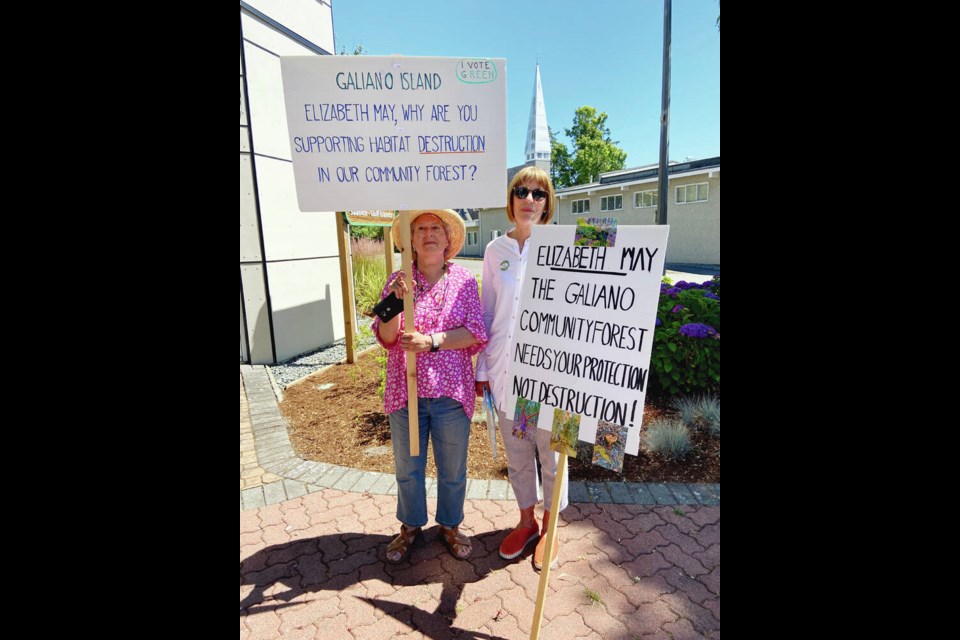Galiano Islanders are divided about a proposed affordable rental-housing project, with supporters eager to help alleviate the desperate shortage of housing, while others decry the loss of land now part of a community forest.
The Gulf Islands Galisle Affordable Rental Housing Society proposal to build 12 units in two one-storey clusters goes to a public hearing before the Galiano Local Trust committee on Saturday.
If the plan is approved, the Galiano Club, which owns the five-acre property, will sell it to the society, board member Colleen Doty said Tuesday.
The need for housing on the island is “heartbreaking,” she said — every year, families leave the island because they do not have housing. The shortage is affecting the younger generation, who grew up on the island and are part of the local workforce, she said.
“They cannot afford to live here, either in renting or owning land, and we have no secure rental housing for non-seniors.”
All the units in the proposed development would be lower-cost, with the maximum paid no more than 30 per cent of the median income among southern Gulf Island residents, she said. Some renters would qualify for lower rates.
Costs for the project would total about $4 million, she said.
The Galiano Club owns and manages 311 acres of community forest, zoned as Heritage Forest, at the end of Georgia View Road on the island. The Galiano Conservancy Association and the Habitat Acquisition Trust are covenant holders over the land.
The chunk of land within the forest area that the housing society is interested in holds mainly young trees and native shrubs. An arborist determined that three of five older Douglas firs on the site have major defects and need to be removed. The others could be preserved by protecting their tree roots.
Doty said the plan includes a 30-foot buffer, where existing trees would be preserved, around the site to create privacy.
The project, which has yet to receive hoped-for government funding, would have one-, two- and three-bedroom units. It would house probably about 32 to 35 individuals on average, she said.
Water and septic analyses have been carried out. The larger forest area has many trails, but Doty said the development would not affect any trails.
If the rezoning is approved, the covenant on that portion of the land would be removed, she said.
Since 2018, a significant amount of work has been carried out to get the project to its current point, including hiring consultants and working with the Islands Trust, Doty said. The site has already been recognized by the local government as a potential affordable-housing site.
Project critics Jennifer Margison and Carmita de Menyhart went to Saanich-Gulf Island MP Elizabeth May’s constituency office in Sidney on Tuesday to protest the proposal. May recently joined the housing society’s board of directors.
May said she previously met with opponents of the project, and continues to study materials provided by Margison. She said she was unable to go to her office on Tuesday because of previous commitments, but would have invited the protesters to talk.
“There’s a real housing shortage and the people who have been working [on it], they have got a very viable proposal. … This is a proposal that has done due diligence,” May said.
Margison said the plan would basically see the site clearcut and a half-kilometre road would be built into the property.
She anticipates that an alley of native big leaf maples would have to be taken down to widen the road and install infrastructure such as culverts. The road is designated a public road but has been gated off.
“This is a really valued recreational area on Galiano. It is one of the few flat areas where people with mobility issues can walk, she said.
“A lot of people come from other parts of the island just to enjoy being in nature and being in the quiet.
Project critics are not anti-housing, Margison said. “Our point is that this is a very inappropriate site for housing development and there are other locations on the island that should be considered.”
People need affordable housing, she said, “but this is too big, too dense and in the wrong site.”
There are major water problems in the neighbourhood and she worries that the project’s septic system will be at a higher grade than residential wells below, Margison said.
De Menyhart noted that people who move into the development would have to use vehicles, because it’s not close to community services.
Margison agreed, noting there is no public transportation on the island. “A parent with several children is not going to be able to manage without a car.”
>>> To comment on this article, write a letter to the editor: [email protected]



